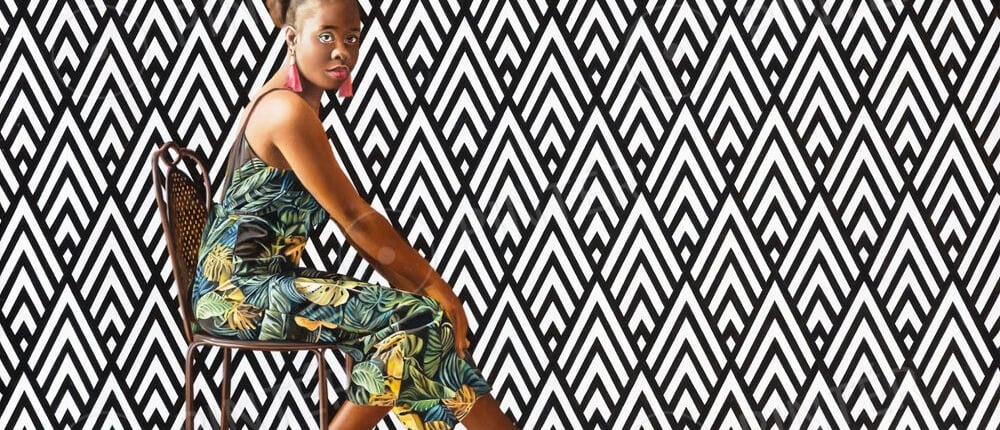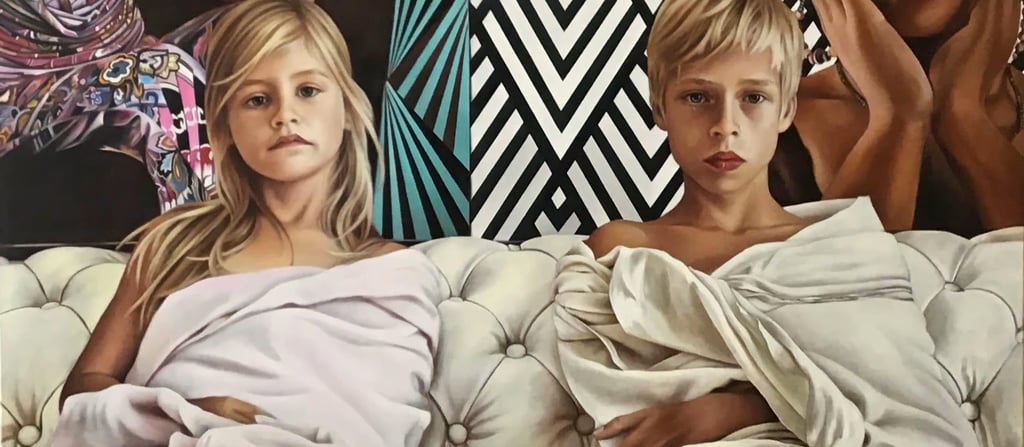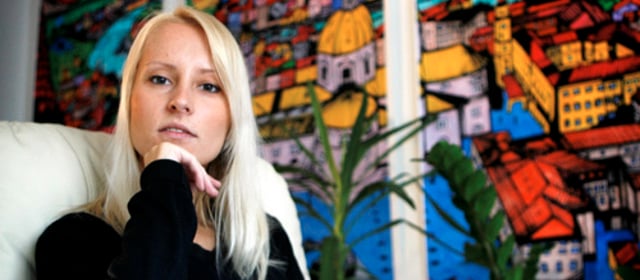Ágnes Zászkaliczky
A visionary Hungarian painter who weaves classical technique, musical heritage, and surreal symbolism into portraits that sing and landscapes that breathe.


Roots in Music and Art: Early Life and Formation
Born in Budapest into an artistic family, Ágnes Zászkaliczky’s childhood was shaped by the twin currents of classical music and visual art. From age six she studied piano and later organ in Szentendre—her father a respected Bach researcher, her mother a piano teacher—which instilled in her a deep sensitivity to rhythm and composition. Parallel to her musical education she began drawing in the Creative Children’s Workshop in Szentendre, under tutors who guided her toward classical portraiture blended with abstraction. Her formal visual training continued at the prestigious Repin Academy in St. Petersburg, where she absorbed the techniques of Russian masters and Caravaggio-style chiaroscuro. This dual formation informs her current portraiture: frames imbued with musical pulse and painterly precision. The result is the rare equilibrium of technical mastery, musical empathy, and symbol-rich portrait composition. Zászkaliczky’s early years across music and visual arts laid groundwork for a career where brushstroke and notation share the same conceptual field, and the face becomes both instrument and archive of soul.
Portraiture as Inner Voice: Technique and Character
At the core of Zászkaliczky’s work lies her portrait painting, which she describes as visual music. Employing classical techniques—layers of glazing, light-dark contrasts, and compositional balances learned from the old masters—she crafts images that transcend mere likeness. Her portraits are about presence: each subject is presented with a stillness that feels alive, an internal rhythm made visible through painting. Faces seem to resonate with emotional complexity, framed by backgrounds that often incorporate abstraction and geometric motifs. These elements act like musical notation around the figure, suggesting harmony, dissonance, or narrative tension. Zászkaliczky’s portraits never feel static; instead, they capture the person’s soul, the emotional architecture behind the gaze. Whether painting musicians or private individuals, she achieves a rare synthesis of technical discipline, psychological depth, and aesthetic tension, making each piece feel like a song of visual character that unfolds subtly over time.
Themes of Memory, Music, and Impermanence
Zászkaliczky’s work often returns to themes of transience, cultural loss, and memory. In her Venice series she uses dissolving reflections and fragmented cityscapes to evoke pending disappearance. Portraits of musicians—such as her series on Leonard Bernstein—are both tribute and elegy: figures captured mid-movement yet framed in stillness. Her paintings evoke a tension between permanence and vulnerability, highlighting the visual weight of absence as much as presence. Across exhibitions and curated multimedia projects, she invites viewers to contemplate humanity’s precariousness—not directly with slogans, but through aesthetic stillness, symbolic surfaces, and lyrical composition. Her work lives between nostalgia and urgency, remembering cultural icons while warning of their fading.
Collaboration with Performance Art and Opera
As a visual and production designer, Zászkaliczky extends her canvas into theatrical spaces. In Carmina Burana, her visual concept was integral: stage design, projection mapping, and lighting formed narrative gestures that complemented Orff’s music. Her upcoming project Magic of Vivaldi: The Four Seasons at Margitsziget Open‑Air Theatre promises to blend orchestral performance with digital visuals, choreography, and immersive stagecraft. These large-scale collaborations reflect her belief in art as holistic experience and demonstrate her command of both painting and live production. She merges classical discipline with contemporary media, offering audiences not just visual art but multi-sensory storytelling.
Latest Exhibitions
Recently Ágnes Zászkaliczky has held major solo exhibitions and participated in high-profile group shows. In 2024 she presented Portraits und Landschaften at Taith Contemporary Gallery in Vienna, offering new paintings combining portraiture and spatial abstraction. In 2023 she exhibited at the Vajdahunyad Contemporary Exhibition at Budapest’s Castle Vajdahunyad alongside sculptor István Parlag, blending sculptural dialogue with painterly rhythm. Earlier in 2024 she was part of the XX. Táblaképfestészeti Biennálé at REÖK Palace in Szeged and the Távlat exhibition by the Hungarian Artists Association. In Autumn 2024 she joined Head Up at Taith in Vienna, and she was featured in AI And The New Creativity at Próféta Gallery in Budapest, exploring digital aesthetics. In 2025 she will exhibit Venice I. at the London Art Biennale, and participate in group exhibitions including Rot sehen in Vienna’s Blaue Galerie. These recent events show her engagement with both classical painting venues and cutting-edge thematic exhibitions exploring intersection of tradition and future media.
Official Links
Explore Ágnes Zászkaliczky’s portfolio, upcoming exhibitions, and artistic statements at her official website: https://www.zaszkaliczkyagnes.com/
Follow her visual updates and exhibition announcements on social media:
Instagram: @agneszaszkaliczky


Musical Interiors and Cross-Media Vision
Drawing on her lifelong practice as an organist and artistic director of major music productions, Ágnes Zászkaliczky approaches painting as if composing sound. Her background in musical structure informs both brushwork and spatial arrangement within canvases: rhythm emerges through repeated forms or brush patterns; balance echoes musical harmony. She has collaborated extensively in stage design, most notably for the Hungarian State Opera’s spectacular production of Carmina Burana, where visuals were coordinated with live music and 3D video-mapping. She serves as visual designer for major immersive performances—including Magic of Vivaldi: The Four Seasons—where painting, motion, dance, and orchestral score merge. These immersive projects reveal her interdisciplinary ambition: to shape not only static images but entire experiential environments where visual art, classical music, and kinetic design co-constitute emotion.
Global Exhibitions and Symbolic Worlds
Since her first solo exhibition in Szentendre in 2001 Ágnes Zászkaliczky has exhibited widely across Europe and North America. She has shown in Budapest, Vienna, Helsinki, Palm Beach, and participated in international fairs like Art Wynwood and Context Art Miami. In 2024 she was long-listed for the UK’s prestigious Aesthetica Art Prize and exhibited in York. In 2025 she was selected to represent Hungary at the London Art Biennale in Chelsea Old Town Hall—a major milestone—where her large-scale painting Venice I. explores themes of urban fragility, climate loss, and cultural memory, rendered through dissolving architectural forms and symbolic water motifs. Her work has appeared in group exhibitions such as the REÖK Palace Biennale in Szeged and thematic shows on "AI and New Creativity" in Budapest. Critics emphasize her ability to weave the timeless intimacy of portraiture with symbolism suggesting broader narratives—climate, identity, cultural disappearance—making her landscape both deeply personal and urgently global.






Awarded with the Highest Distinction
Ágnes Zászkaliczky was granted the Excellence Award for her masterful fusion of classical painting technique with contemporary symbolism, her rhythmic visual compositions that echo musical structure, and her capacity to elevate portraiture into emotional narrative. Her work is worth seeing not only for its technical brilliance, but for the way it translates sound into color, performance into pattern, and identity into composition—each canvas a resonance of culture, memory, and artistic integrity.






